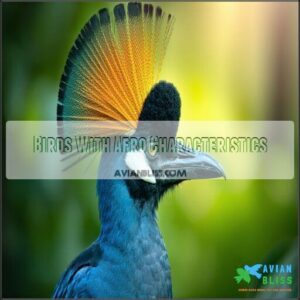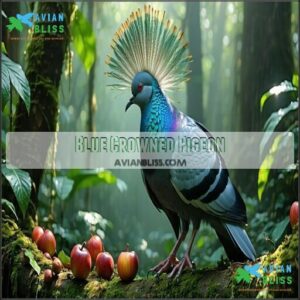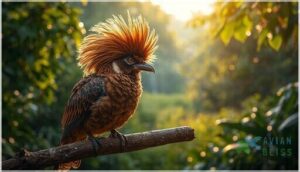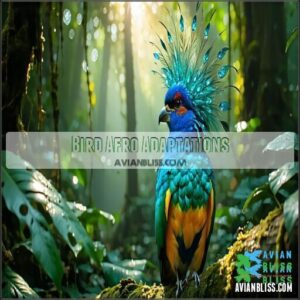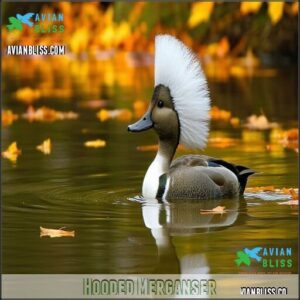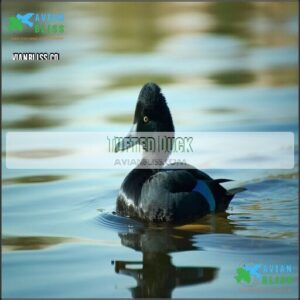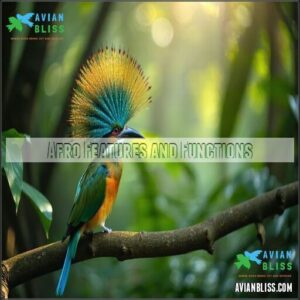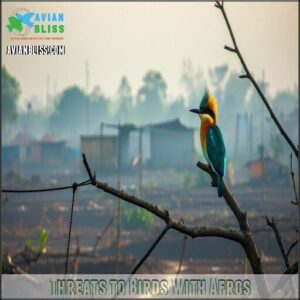This site is supported by our readers. We may earn a commission, at no cost to you, if you purchase through links.
 A "bird with afro" isn’t just a quirky idea—it’s a real thing.
A "bird with afro" isn’t just a quirky idea—it’s a real thing.
Take the crested duck, for example, its fluffy, afro-like crest comes from a harmless genetic mutation that gives it a crowd-pleasing look.
Then there’s the striking Andean cock-of-the-rock, with its bright orange pompadour, or the regal Victoria crowned pigeon, rocking a lacy blue crest that screams elegance.
These crests aren’t just for show—they help with communication, attracting mates, or even scaring off predators.
Birds with afros often thrive in rainforests, grasslands, or wetlands, adapting to their environments in fascinating ways.
Curious about their conservation? Keep exploring!
Table Of Contents
- Key Takeaways
- Birds With Afro Characteristics
- Types of Birds With Afros
- Habitat and Distribution
- Bird Afro Adaptations
- Duck Species With Afros
- Afro Features and Functions
- Threats to Birds With Afros
- Conservation Efforts
- Afro-like Feathers Importance
- Bird With Afro Conservation
- Frequently Asked Questions (FAQs)
- Can you see a duck with an Afro?
- Are there any Ducks with afros?
- Who is the most famous duck with afros in pop culture?
- Why are ducks with afros called crested ducks?
- Why are ducks with afros so popular?
- How to dress a duck with afros?
- What is the name of the bird with crazy hair?
- What kind of bird is a huge black bird?
- Do some birds have hair instead of feathers?
- Do any birds have curly feathers?
- Conclusion
Key Takeaways
- Birds with afro-like crests, like the Crested Duck and Andean Cock of the Rock, use their unique feathers for communication, mate attraction, and survival.
- Afro-feathered birds thrive in diverse habitats such as rainforests and grasslands but face threats from habitat loss, climate change, and illegal wildlife trade.
- These crests function beyond looks, aiding in temperature regulation, camouflage, and social signaling within flocks.
- Conservation efforts like habitat preservation, breeding programs, and public awareness are crucial to protect these striking bird species.
Birds With Afro Characteristics
You’ll notice birds with afro-like crests have unique feather structures that make their head plumage stand out.
These hair-like crests play essential roles in communication, temperature regulation, and even survival.
Unique Feather Structure
Ever wonder what makes an afro hairstyle bird so striking? It’s their feather structure—a perfect mix of art and engineering that gives them their unique bird look while guaranteeing survival.
A brilliant blend of nature’s artistry and engineering, afro-crested birds flaunt feathers that are both functional and fabulously unique.
Here’s how it works:
- Keratin Composition: Feathers are strong yet flexible, thanks to keratin.
- Feather Barbs: Microscopic barbs interlock to create warmth and durability.
- Insulation Properties: Feathers trap air, helping regulate body temperature.
- Coloration Origins: Melanin pigments add bold patterns to their plumage.
- Structural Integrity: Sturdy quills guarantee crests stand tall and proud.
These brilliant adaptations don’t just look stylish—they’re vital for survival, blending beauty with function in every bird with afro-like features.
Exuberant Hair-like Crest
While many birds with afros are celebrated for their unique personalities, it’s their exuberant hair-like crests that truly steal the spotlight.
These striking crests—of various shapes, sizes, and colors—serve as evolutionary marvels, blending function with style.
From the fluffy afro of the Crested Duck, used for mating displays, to the spiky mohawk of the Hoopoe, designed to ward off rivals, these features highlight the diversity of crest development.
Crest Feature Bird Example Purpose
Ultimately, a bird with “big hair” showcases trillions of feather compositions, shaped by genetic factors.
Communication Roles
Those afro-like crests are like nature’s very own messaging app for birds.
They blend movements, colors, and vocalizations to ‘speak’ without a single word.
Here’s how:
- Mate attraction: Males fluff their crests to impress and draw attention during courtship. Think of it as their stylish dance move!
- Threat displays: Quick crest flicks warn predators or rivals to back off.
- Social signaling: Crest positions reveal mood or rank within their flock, supporting bonding and order.
This bird communication system, pairing crest displays and vocal mimicry, fosters inter-species connections and harmony.
Types of Birds With Afros
You’ll find a variety of birds with afro-like crests, each with unique features that serve specific purposes.
From the Crested Duck’s cloud-like puff to the elegant Blue Crowned Pigeon’s feathered crown, these traits highlight fascinating adaptations in the avian world.
Crested Duck
Among birds flaunting unique traits, the Crested Duck is a true standout. With its fluffy afro-like crest, it’s a fascinating example of nature’s whimsy. This charming feature originates from a genetic mutation affecting the skull, giving Crested Ducks their signature tuft.
It’s not just for looks—it has made them one of the most beloved duck breeds. Crested Ducks come in various sizes and colors. The standard ones weigh 6-7 pounds, while the smaller Crested Duck Varieties, like miniatures, are under 3 pounds.
These ducks, often seen in black or white, require careful care. Their crest structure demands attention to prevent injuries or infections. Though health challenges arise from the mutation, they’re still valued for their visual appeal and as quirky pets.
Breeders carefully control Crested Duck Breeding to guarantee healthier offspring. Their fluffy crests certainly leave a lasting impression!
Andean Cock of The Rock
If you’re exploring the cloud forests of South America, the Andean Cock of the Rock is a showstopper.
Its bold, disc-shaped crest—a vibrant orange afro—makes this bird hard to miss. As Peru’s national bird, it thrives in humid forests and rocky ravines, creating nests on steep cliffs for safety.
Males are the stars here, flaunting bright red-orange plumage with striking black wings and tails. Females, with their softer brown coloration, still maintain that distinctive headpiece.
These birds gather at communal spots called leks, where males perform mesmerizing mating displays.
- Mating displays involve energetic head-bobbing, wing-flapping, and croaking calls that echo through the cloud forest.
Their diet primarily consists of fruits and berries, supplemented with insects and small animals. As seed dispersers, they play a major role in forest conservation.
Truly, a bird whose afro style is unmatched!
Blue Crowned Pigeon
In New Guinea’s vibrant forests, the Blue Crowned Pigeon captivates with its stunning bird afro style.
Its feathered crown, an intricate display of plumage coloration, showcases nature’s finest bird afro fashion, blending elegance and functionality.
These gentle giants, nearly the size of a chicken, rely heavily on their forest dependence for survival and gather food from the ground.
Their diet specifics include fallen fruits and occasional insects, adding variety to their meals.
During courtship, males use vocal communication, bowing gracefully while emitting soft coos—a unique blend of charm and showmanship.
As a bird with afro, it thrives in protected habitats, though captive breeding programs have supported its conservation globally.
Habitat and Distribution
You’ll find birds with afro-like crests in habitats ranging from tropical rainforests to savannah grasslands.
These environments provide the perfect conditions for nesting, feeding, and the unique adaptations that help them thrive.
Tropical Rainforests
Tropical rainforests are paradise for birds with afros, offering lush canopies and endless resources.
These vibrant forests allow species like the Andean Cock of the Rock to thrive, showcasing their striking “bird afro fashion.”
- Canopy Nesting: Tall trees protect nests from predators.
- Rainforest Biodiversity: Rich ecosystems support afro-adorned birds.
- Avian Diets: Fruits and insects fuel colorful plumage.
- Climate Impact: Rainforests regulate humidity for feather care.
- Tropical Deforestation: Habitat loss threatens afro-clad species.
These habitats nurture evolution while highlighting nature’s adaptability.
Savannah Grasslands
Savannah grasslands are home to some of the most striking birds, each flaunting a unique "afro." Species like the Crested Guineafowl and Grey Crowned Crane thrive here, perfectly adapted to the open plains.
Their crests aren’t just for show—they play roles in camouflage techniques, mate attraction, and signaling dominance. Bird habitats in grasslands require adaptability to dry seasons, wildfires, and limited shade.
These birds, like others around the world, occupy unique bird habitats that determine their survival.
Here’s a quick snapshot of notable savannah species:
| Bird Species | Afro Characteristic |
|---|---|
| Grey Crowned Crane | Golden plume |
| Crested Guineafowl | Black tufted crest |
| Secretary Bird | Spiky head feathers |
| Southern Ground Hornbill | Red wattle crest |
| African Grey Parrot | Smooth head (honorary mention) |
Their diets include insects, seeds, and small prey.
Their nesting habits involve ground-level or shrub nests to avoid predators.
Adaptation Mechanisms
Nature’s ingenuity shines in the adaptation mechanisms of birds with afros. These unique traits go way beyond appearance, helping them survive in challenging environments.
- Feather Insulation: The specialized feather structure traps air, keeping these birds warm in cold climates and cool in heat.
- Crest Thermoregulation: Birds can raise or lower their natural bird hair (crests) to regulate body temperature, adjusting it by up to 3°C.
- Camouflage Strategies: Crest patterns break up their body outlines, making them less visible to predators.
- Behavioral Shifts: During mating, crests act as “signals,” with vibrant plumage revealing health and genetic quality.
- Evolutionary Advantages: Dominant birds with more prominent crests often secure better mates and higher social status.
These bird adaptations demonstrate the powerful link between functionality and beauty in bird evolution and behavior.
Bird Afro Adaptations
Birds with afro-like crests have adaptations that help them regulate body heat, blending into their environment with ease.
These unique features also support behaviors critical for survival, like attracting mates and avoiding predators.
Heat Regulation
Birds with afros have a clever way of staying cool using their unique crests. These crests work as natural radiators, balancing heat efficiently.
Through feather insulation, specialized plumage, and behavioral thermoregulation, they manage body temperature effectively.
Here are five cooling techniques birds use:
- Widen their tufts to trap or release heat.
- Regulate blood flow to adjust crest temperature.
- Employ evaporative cooling by panting when it’s hot.
- Angle crests to catch breezes for better ventilation.
- Let heat radiate through specific feather structures.
Crest coloration may also play a role in reflecting or absorbing heat. These adaptations make their bird anatomy ideal for handling heat, ensuring survival in various climates with minimal energy.
Camouflage Abilities
In terms of blending in, birds with afros are masters of camouflage abilities. Their feather patterns aren’t just stylish—they’re life-saving.
Their unique feather structure adds another layer of defense by breaking up their outline, creating an almost invisible silhouette in dense habitats. Even their plumage, with intricate bird colors, plays a role in habitat blending.
When faced with danger, they freeze, relying on their clever design for predator avoidance. For example, nesting females use camouflage to protect their eggs, utilizing color mimicry and disruptive coloration to match their surroundings perfectly.
Behavioral Adaptations
From heat regulation to blending in, afro-crested birds have fascinating strategies up their sleeves.
A standout feature is their behavioral adaptations—not just for survival, but for thriving.
These birds make clever use of their plumage, especially their crest displays, to dominate social dynamics or charm potential mates.
For instance, a Crested Duck’s rhythmic head-bobbing works both as a warning system and a signal of confidence.
Similarly, the Blue Crowned Pigeon’s crest-raising posture commands attention, almost like royalty in the room.
Their actions aren’t random.
Flocks teach younger birds survival tricks, emphasizing predator avoidance and better foraging strategies through social learning.
Plus, you’ll see Hooded Mergansers moving in near-perfect sync during migrations, a visual harmony that guarantees safety in numbers.
With their sharp instincts and coordinated efforts, each bird with afro proves that style and substance can coexist seamlessly in nature.
Duck Species With Afros
You’ll find some fascinating ducks with afro-like crests that serve both functional and aesthetic purposes.
Species like the Hooded Merganser, Tufted Duck, and Red-breasted Merganser showcase unique feather adaptations that aid in communication and survival.
Hooded Merganser
The Hooded Merganser is a standout among ducks with afros, flaunting a retractable fan-shaped crest that’s both functional and stylish. Unlike Crested Ducks, their crests aren’t genetic quirks but purposeful adaptations.
You’ll spot these waterfowl in North America’s wooded ponds, where their striking dimorphic plumage features make them hard to miss. Males display bold, white crests during courtship, leveraging this trait for maximum impact. The crest display function extends beyond aesthetics—it’s a key communication tool.
Their underwater hunting skills are unmatched:
- Hooded Merganser diet includes fish, crayfish, and aquatic insects.
- A saw-like bill guarantees effective prey capture.
- Retractable crest mechanisms enhance agility in water.
However, they face conservation challenges due to habitat loss.
Tufted Duck
The Tufted Duck stands out among duck breeds with a sleek, dangling crest that looks like a natural “duck afro.” This crested duck’s crest morphology plays a role during courtship, catching attention with its striking plumage variation.
It’s not just about appearances – Tufted Ducks are incredible divers, disappearing underwater for up to 25 seconds to grab a quick meal. The typical Tufted Duck diet includes aquatic insects, small fish, and plant material.
Preferring freshwater lakes and slow-moving rivers, these ducks also maintain an impeccable grooming routine to keep their signature tuft. Observing their breeding habits and stunning look makes them one of the most enchanting crested duck varieties.
Red-breasted Merganser
The Red-breasted Merganser stands out as a bird with afro-like, "punk-rock" hair, making it one of nature’s coolest designs.
Unlike the sleek Tufted Duck, these quirky speedsters are the fastest waterfowl, reaching up to 100 mph! Their serrated beaks are perfect for catching slippery fish, and their exceptional diving skills take them 30 feet underwater with ease.
You’ll often find them in coastal habitats during winter migrations.
- Breeding Habits: Prefer secluded freshwater zones.
- Diet Variations: Mostly fish, insects, and crustaceans.
- Population Threats: Habitat loss and climate change pressures.
Afro Features and Functions
You’ll find that a bird’s afro-like crest isn’t just for show—it plays key roles in their survival and communication.
These unique features are used for attracting mates, warning rivals, and even enhancing vocal displays.
Mating Rituals
Those striking, afro-like crests are more than just feathered fashion—they’re essential for courtship displays and partner selection.
Afro-like crests aren’t just style—they’re nature’s breathtaking way of showcasing charm, dominance, and the art of attraction.
Birds use their crests to dazzle potential mates with ritualistic dances, showcasing health and strength. The Andean Cock-of-the-Rock bobs energetically, its vibrant crest signaling vigor.
The Victoria Crowned Pigeons bow gracefully while inflating their chests, emphasizing crest significance in mate attraction. Even Crested Ducks use head shakes and synchronized moves to promote compatibility.
These bird displays rely on visual appeal, making crests a pivotal tool in mating rituals for attracting partners. These displays are key communication signals in mate selection.
Vocalizations
Bird vocalizations are nature’s symphony.
Birds with afros use unique calls to communicate, attract mates, and claim territories. You’d hear Crested Duck calls blending into calm waters or Pigeon cooing sounds resonating in forests.
Mergansers expand their vocal range in wooded ponds. Guineafowls rely on sharp alarm calls for alerting flocks, while Curassows serenade with deep mating songs.
These sounds aren’t just noise—they’re precise signals shaped by evolution.
- Crested Duck calls: Soft, soothing tones by water
- Pigeon cooing sounds: Calming rhythmic notes
- Bird vocalizations: Essential for group harmony
- Avian communication: Essential for survival and relationships
Threat Displays
In the context of defense, a bird with afro-inspired plumage knows how to stand its ground.
Using dramatic posture changes, flashy crests, and sharp vocal warnings, these birds deliver clear aggression signals to intimidate rivals or predators.
Their crests, designed for eye-catching mating displays, also serve as clever tools for defense.
By fluffing or adjusting crest size, they amplify their appearance, making a strong visual statement.
In some cases, birds even engage in ritualized combat, displaying dominance through calculated moves.
These impressive behaviors aren’t just about survival—they highlight the intricate bird behavior that marries style and practicality, with elegance transforming into a shield of intimidation.
Threats to Birds With Afros
You’ll find that birds with afro-like crests face serious threats, including shrinking habitats due to deforestation and urban spread.
Climate change and illegal wildlife trade also put pressure on their survival, reducing their numbers in the wild, which is a result of shrinking habitats.
Habitat Loss
Habitat loss poses serious challenges for afro-topped birds. Factors like deforestation impacts, agricultural expansion, and urbanization effects strip away essential nesting places. Fragmentation risks make survival even harder, isolating populations and reducing gene flow.
To support local ecosystems, consider planting native species. Wildlife conservation is essential. You can help protect these endangered species by supporting bird conservation initiatives.
- Preserve forests: Advocate for sustainable logging and reforestation.
- Restore habitats: Encourage programs to rebuild natural ecosystems.
- Promote awareness: Educate communities about conservation efforts.
Illegal Wildlife Trade
Illegal wildlife trade threatens birds with afros, like the Blue Crowned Pigeon and African Grey Parrot, pushing these species closer to extinction.
Poaching is driven by the bird afro trend, fueled by market dynamics and exotic pet demand. Weak enforcement often fails to stop smuggling operations.
Here’s how trade drivers operate:
- Poachers capture birds in regions hit by deforestation or habitat loss.
- Smugglers use hidden routes to move birds undetected.
- Ineffective laws and enforcement allow traffickers to avoid penalties.
- Buyers unknowingly support this illegal cycle due to low consumer awareness.
Sustainable alternatives and stricter enforcement can protect these species.
Climate Change
Climate change is rewriting the story for afro-crested birds, reshaping their lives in surprising ways.
Rising temperatures push these vulnerable species uphill, forcing habitat shifts that shrink their living spaces.
Wetlands, critical for feeding and nesting, are disappearing as sea levels rise, leading to food scarcity.
Erratic weather alters migration patterns, disrupting breeding impacts and leaving birds stressed.
Even the stunning crests of these endangered species face discoloration, a sign of declining health.
Here’s a snapshot of climate change impacts:
| Impact | Cause | Effect on Birds |
|---|---|---|
| Habitat Shifts | Rising Temperatures | Loss of space, competition |
| Crest Discoloration | Malnutrition | Poor mate attraction |
| Breeding Impacts | Weather Changes | Decline in offspring survival |
| Migration Changes | Unpredictable Seasons | Disrupted life cycles |
Protecting their world depends on targeted conservation efforts, like habitat restoration and emission reductions.
Conservation Efforts
You can play a pivotal role in protecting birds with afro-like crests by supporting conservation efforts focused on their habitats.
These efforts include establishing protected areas, encouraging community involvement, and promoting research to better understand their needs.
Protected Areas
Protected areas, like National Parks and Wildlife Reserves, are essential for afro-crested birds.
These sanctuaries serve as safe havens, ensuring habitat protection and wildlife preservation without human interference. Area management focuses on habitat restoration, species monitoring, and reserve funding to keep these regions thriving.
Imagine these spaces as nature’s way of offering birds like the Blue Crowned Pigeon a perfect shelter. These protected areas often require specialized habitat products to maintain their suitability.
- **Did you know?
** Protected areas rely on local involvement to succeed. Communities living nearby play an important role in conserving ecosystems and ensuring birds with afro-like crests remain undisturbed.
Research Initiatives
To understand the fascinating world of birds with afros, scientists focus on research that reveals their secrets.
Here’s how:
- Genetic Studies: Experts examine the DNA behind crest development, showing why some birds boast stylish plumage.
- Behavior Analysis: Fieldwork tracks movements and habits, like how species adapt to changes in their habitat.
- Conservation Genetics: This helps protect species by understanding genetic diversity, essential for long-term survival.
Studying crested bird genetics can further inform these initiatives.
- Habitat Impact: Researchers analyze environmental changes affecting birds with afros, planning smarter conservation.
These efforts amplify what makes bird research so vital: preserving their beauty while unraveling nature’s mysteries.
Community Engagement
Community engagement matters regarding protecting birds with afros.
You can join bird watching communities, participate in citizen science, or promote bird appreciation through educational programs.
Hosting bird awareness events like fundraisers raises essential resources while inspiring others.
Adopt bird-friendly habits, encourage sustainable livelihoods, and explore ecotourism to support conservation efforts.
Habitat loss endangers many bird species, making conservation efforts vital.
Explore forums or social media to share knowledge and deepen bird education.
Together, these actions make a real difference.
| Activity | Purpose | Impact |
|---|---|---|
| Bird Watching Groups | Promote bird education | Foster local involvement |
| Citizen Science | Collect research data | Strengthen conservation |
| Fundraising Events | Generate resources | Support sustainable efforts |
| Social Media Platforms | Share bird appreciation | Expand community awareness |
Afro-like Feathers Importance
Afro-like feathers play a key role in how birds communicate and signal their presence in their environment. These crests also help attract mates and establish social status within their species.
Avian Communication
Birds with afros have mastered the art of avian communication, blending crest displays, vocal mimicry, and feather signals into their daily lives.
Those striking crests aren’t just stylish—they’re tools for bird-to-bird interaction. You’ll see their unique "afro acoustics" shine in social and territorial exchanges.
Here’s how these feathered communicators stand out:
- Use vocalizations to deliver courtship calls or warn rivals.
- Raise their crest as visual markers of dominance or excitement.
- Perform ritualized dances paired with feather signals to charm potential mates.
- Engage in territorial standoffs by flashing vibrant crests.
- Bond flocks through chirps that reinforce social ties.
Their actions make understanding this natural language fascinating.
Mate Attraction
Courtship displays in birds with afros work like a nature-made talent show.
Their extravagant crests, vibrant colors, and ritualized dances showcase a genetic advantage designed for mate attraction.
The crested duck’s fluffy afro crest draws female preference instantly, while the Andean Cock of the Rock uses its bold plumage to demand attention.
Display behavior often features rhythmic movements, signaling confidence and fitness.
These visual cues, paired with elaborate courtship rituals, make each moment enchanting for potential mates, strengthening reproductive success through precise, specialized adaptation.
Social Status
Flaunting their afro-like crests, Birds with afros showcase social status within their flocks through size, color, and shape.
These crests aren’t just decorative; they’re tools for dominance displays and courtship success.
Here’s how crests highlight hierarchy:
- Crest Size commands respect, signaling dominance within flock dynamics.
- Bright colors attract mates during courtship displays, showing liveliness.
- Distinct shapes help assert territory defense.
- Thick feathers communicate strength and resilience in mate selection.
- Glossy textures indicate health and high-ranking status.
Through crests, a bird with an afro sends a clear message: it belongs at the top!
Bird With Afro Conservation
You play a pivotal role in protecting birds with afro-like crests, such as the Victoria Crowned Pigeon, whose habitats face ongoing threats.
By supporting conservation efforts like habitat preservation and research programs, you help guarantee their survival for future generations.
Victoria Crowned Pigeon
The Victoria Crowned Pigeon captivates with its delicate, lace-like plumage and royal demeanor.
Native to New Guinea, this standout among birds with afros thrives on a diet rich in fruits and seeds.
Its courtship behavior includes soft cooing calls and suave displays.
Plumage variations enhance its elegance, and fastidious feather care keeps its afro-like crown pristine.
Conservation threats highlight its vulnerability, but captive breeding programs support this incredible bird species with remarkable bird diversity.
Conservation Status
Many afro-feathered birds face a tough reality, with their conservation status sounding the alarm.
Habitat destruction, illegal wildlife trade, and climate impacts are driving their numbers down, threatening ecosystems and balance. These birds don’t just boast stunning crests—they play essential roles in biodiversity.
- Habitat loss: Farming and deforestation strip them of their homes.
- Climate change: Breeding cycles falter as ecosystems shift.
- Genetic diversity: Shrinking populations weaken long-term survival.
Wildlife conservation hinges on bold action. Population trends reveal the urgency: without habitat protection, breeding programs, or focused conservation initiatives, bird preservation will remain at risk. Their survival is in our hands.
Preservation Strategies
Restoring forests and grasslands is your first step to protecting birds with afros.
Proper habitat restoration creates safe nesting areas while reversing habitat loss.
Keeping a close eye on populations through species monitoring helps guide future conservation efforts.
To give these birds a fighting chance, captive breeding programs boost their numbers and maintain genetic diversity.
At the same time, anti-poaching measures guarantee their survival in the wild.
You can support these efforts through habitat restoration products.
Conservation isn’t just about science – you can play a role too.
Promote public awareness by spotlighting their importance and supporting local wildlife conservation projects.
These preservation strategies are the key to securing afro-crested birds’ future.
Every crest symbolizes nature’s beauty – let’s help keep them a part of our world.
Frequently Asked Questions (FAQs)
Can you see a duck with an Afro?
Yes, you can spot a duck with an Afro!
Crested Ducks have fluffy, cloud-like crests caused by a genetic mutation.
These unique "hairstyles" make them unforgettable, often seen waddling gracefully in ponds or backyards.
Are there any Ducks with afros?
Crested ducks have a genetic mutation giving them fluffy, afro-like crests.
These adorable ducks, often seen in white or black, wear their "hairstyles" like a crown.
It’s both a charm and a quirky feature!
Who is the most famous duck with afros in pop culture?
The most iconic duck with an afro in pop culture is the Crested Duck.
Its fluffy, cloud-like crest resembles a dapper hairstyle, capturing people’s curiosity and making it a memorable figure in pet shows worldwide.
Why are ducks with afros called crested ducks?
They’re called crested ducks because of the tuft of feathers on their heads, which looks like a fluffy "crest."
This unique feature is caused by a genetic mutation affecting the duck’s skull structure.
Why are ducks with afros so popular?
Ducks with afros grab attention with their unique crests, giving them a quirky, stylish look.
They stand out as a conversation starter, perform well in shows, and appeal to pet enthusiasts seeking something rare and eye-catching.
How to dress a duck with afros?
To dress a duck with afros, consider a lightweight, breathable costume that doesn’t hinder movement or disturb its crest.
Use soft, non-restrictive fabrics and make certain proper ventilation for comfort and safety.
What is the name of the bird with crazy hair?
It’s like a bird having a wild hair day—meet the Crested Duck or Andean Cock of the Rock.
These birds flaunt vibrant, afro-like crests that are both stylish and functional for survival.
What kind of bird is a huge black bird?
A huge black bird you’re asking about might be the Great Curassow.
It’s a striking creature from Central America, flaunting curly, afro-like feathers on its head, a sleek black body, and confident presence.
Do some birds have hair instead of feathers?
It’s fascinating, but birds don’t have hair—they have feathers exclusively.
Some crests or tufts might resemble hair, like afros or mohawks, but they’re specialized feathers for display, warmth, or communication, not actual hair.
Do any birds have curly feathers?
Yes, some birds have curly feathers.
Frillback pigeons are a great example, with their unique curled plumage.
Curl-crested aracaris and great curassows also sport curly feather features, making their appearance truly distinctive and eye-catching.
Conclusion
Imagine spotting a bird with an afro—it’s like nature’s way of showing off its creativity.
These birds don’t just look unique; their crests serve key purposes like attracting mates, communicating, or blending into their habitats.
From rainforests to grasslands, they’ve adapted impressively to survive.
But threats like habitat loss and climate change mean active conservation is necessary.
By protecting these feathered wonders, you’re helping preserve biodiversity and ensuring future generations can admire their striking beauty.

